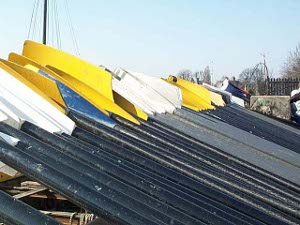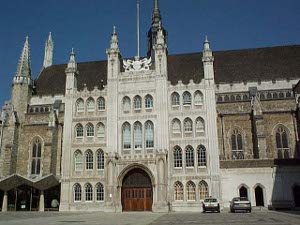 The City Barge pub
The City Barge pub
The weather has cleared up. The sky is a brilliant, cloudless blue and even the wind seems to have calmed, at least a bit. Just before breakfast we heard an unusual noise and looked out the window to see a long column of dark horses clopping down Albany Street, three abreast, with one yellow-jacketed rider for every rank of three. It seemed an excellent start for an adventurous weekend.
 The City Barge pub
The City Barge pub
We put our new guidebook, Walking London, to good use. Saturday we walked four and a half miles from Kew to Hammersmith, and Sunday another couple of miles through the deserted alleyways of the City of London.
We began our walk by visiting Newen's Tea Rooms and purchasing two Maids of Honour tarts, named after the attendants of Princess Caroline of Anspach. The Royal Botanic Gardens at Kew were started by Princess Augusta, the wife of Prince Frederick of Wales and mother of King George III. She worked on the gardens and plantings until her death in 1772. Over the years the gardens were expanded from 9 acres to the present size of over 300 acres. Most of the eighteenth century royal houses have been torn down, but the gardens have prospered, and were given to the nation by Queen Victoria in 1899. The estate includes libraries and laboratories for botanical research and preservation of dried specimens. The houses near the gardens are a pleasant mixture of large old brick and stone homes, many of which have been divided but still retain their dignified doorsteps and windows.
We walked through Kew to the banks of the Thames River. We have no English bird book, and the birds all look slightly different from their American variants. The geese have no green feathers, the coots have a white splash on their foreheads, the cormorants aren't as black. The gulls, however, are unmistakeable, by sound if not by sight!
 Shells ready to race
Shells ready to race
It seemed as if our walks took us from one ancient pub to another, with ancient churches only a little less frequently encountered. An old pub on the Thames was called the City Barge, as the Lord Mayor of London moored his state barge there. It had a no-nonsense steel door that could seal off the pub from the high waters of the Thames. We were impressed by the high water mark part-way up the door. The river was perhaps fifteen feet below that flood line today, and Londoners took advantage of the fine weather to stroll along the paths.
The river makes a wide meander, and we cut across towards Chiswick House. Just before entering the grounds, we witnessed a hit-and-run; only a parked car was hit as a flying delivery truck neatly clipped off the passenger-side mirror on a BMW SUV. The lady ahead of us trotted into the closest house and emerged with an elderly man who took quite a bit of time to register what had happened. The parts of the shiny blue BMW mirror had hit the street and bounced to the kerb just next to his modest green Honda. Finally, when the occupant realized his car wasn't damaged, he relaxed. It was good luck for  Rowers' tools
him, he remarked . . . No word was spoken as to who might own the BMW.
Rowers' tools
him, he remarked . . . No word was spoken as to who might own the BMW.
We walked through Chiswick Park. Families with children played everywhere, running on the lawns, by lakes and ponds, ignoring the Grecian urns and obelisks, chasing balls and frisbees. A little yappy dog worried a bird or squirrel up a tree. We had hoped to use our English Heritage pass to view the House, built by an amateur architect in the 1720s in the Palladian style, but (as we learned later) due to a shortage of volunteer docents, the House will not open this year until 1 April. Too bad. The grounds were lovely, anyhow.
136 years ago London started putting plaques up on the exterior walls of buildings to commemorate famous persons or events. Initially they were brown, but now they're the familiar blue with white lettering. According to the plans, the people are supposed to be "instantly recognizable to the passerby." Today's plaques included printer Sir Emery Walker, the calligrapher Edward Johnston, and Sir Francis Ronalds, inventor of the telegraph. We failed to recognize them instantly. The more literate one of us did know that A. P. Herbert wrote humorous books about life on the Thames. We both knew one of the Redgrave family who had once occupied Bedford House, but they had not yet earned a plaque on the wall, as one has to be dead quite a while before the plaque is put up.
We had been seeing shells practicing on the Thames for some time as we walked downstream, but as we neared Hammersmith, the banks were crowded with  The Old Dr. Butler's Head Pub
them. Dozens of women's crews from all over the country were energetically preparing to put their boats in the water for some kind of a regatta. We photographed the shells up close, the long and heavy-looking oars, the shoes nailed to the supports, but didn't stay for the races, probably hours off.
The Old Dr. Butler's Head Pub
them. Dozens of women's crews from all over the country were energetically preparing to put their boats in the water for some kind of a regatta. We photographed the shells up close, the long and heavy-looking oars, the shoes nailed to the supports, but didn't stay for the races, probably hours off.
We really like Walking London because it took us down narrow alleys and rights of way that we otherwise might have missed, so the next day, after visiting some more railway stations (you can only get the timetables for each different railroad in the stations they use) we found ourselves near The City, with the book in our pocket.
We knew from a previous visit that The City would be deserted on a Sunday -- all the bankers and brokers safe and snug in their suburban retreats -- but there were a few construction crews happily earning overtime pay for some hurry-up jobs.
We picked up the guidebook walk and again seemed to pass from pub to church and back to pub again. It was surprising to see them all closed. The churches in this part of London have no congregations, but they are patronized by business firms, and open Monday to Friday only. Likewise most of the pubs are closed, even on St. Patrick's weekend, while other city pubs are full of customers. A couple of old churches had walls preserved from before the Great Fire, and a couple of old pubs, too; but the rest of the buildings were built after 1666, in fact generally in the last 200 years.
We liked the elaborate crests over the entrances to the guild houses, now called livery companies. They were once real professional associations of  London Guildhall and courtyard
tanners, mercers, innholders, etc., but now are status-oriented social and charitable organizations. We also liked the tiny alleys and cobbled curving streets found by our guidebook, avoiding all the busy thoroughfares.
London Guildhall and courtyard
tanners, mercers, innholders, etc., but now are status-oriented social and charitable organizations. We also liked the tiny alleys and cobbled curving streets found by our guidebook, avoiding all the busy thoroughfares.
We walked through the courtyard of the Guildhall, nerve center of the Corporation of London. Even the Queen has to get permission from the Lord Mayor to enter here! A part of the wall dates from the 15th century. We could find ourselves returning here to consult their library and archives.
We dropped down to the River, past the Custom House and Sugar Quay to the Tower of London, where the crowds of tourists and vendors reminded us that we had urgent business elsewhere! But approaching the underground station we saw two more sights of interest. A nineteenth century building adorned with heroic sculptures dominated Trinity Square. It is not Trinity House, with its golden weather vane in the shape of a sailing ship; all the lighthouses are automated now. We approached close and discovered that this magnificent edifice is now occupied by an insurance company - Willis. Can anyone tell us what the building was originally? The other sight was a portion of The Wall of London, built by the Romans and fortified with an earth embankment and ditch. In the middle ages it was 20 feet high.